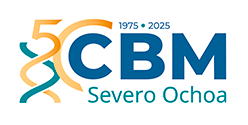Scientific facilities
Animal facility
Facility Head

Blanca Estévez Santiago
Scientific Lead

María Mittelbrunn Herrero
Contact details
91 196 44 49
animalario (at) cbm.csic.es
Fees
The Animal Facility of the CBM, inaugurated in January 2011, occupies an area of about 1500 m2. It has rooms for mice, fish and frogs. The mice are housed in ventilated racks, and are handled in biological safety cabinets. Fish and frogs are housed in specific racks for their maintenance.
The space is divided into the following zones:
- Clean or SPF barrier zone (mouse): It has several rooms where transgenic lines are produced along with their main genetic backgrounds. All mouse lines entering the barrier will do so by embryo rederivation.
- Biosafety level 3 room (mouse), connected by a SAS to the P3 culture room.
- Room with biosafety level 2 (mice).
- Rooms for conventional stabling and experimentation (mice).
- Rooms for behavioral studies (mice): Both in barrier and conventional areas.
- Room with Preclinical Biomedicine service equipment.
- Room for aquatic animals (frogs and fish).
- Laboratory.
- Material washing and processing area.
Users should bear in mind that there are quarantine periods between the different rooms of the Animal Facility or between this Animal Facility and those of other centers.
The work in the Animal Facility is carried out in accordance with current regulations, paying special attention to the health and welfare of the animals. If you’d like more information about this, please go to the Ethics in Animal Research Committee page.
Vacio
Your content goes here. Edit or remove this text inline or in the module Content settings. You can also style every aspect of this content in the module Design settings and even apply custom CSS to this text in the module Advanced settings.
Animal facility services
Work in the Animal Facility is carried out in accordance with current regulations, paying special attention to the health and welfare of the animals.
Internal services offered by the Animal Facility include:
– Maintenance and production of mice.
– Maintenance of fish and frogs.
– Management of transgenic mice colonies.
– Support to researchers in various procedures.
– Technical advice.
– Animal health controls, performed externally.
– Reproductive biotechnology.
Other scientific services located in the Animal facility
Preclinical Biomedicine is a scientific facility that provides scientific-technical advice and support for experimental design and use of small animal experimental equipment. It aims to facilitate preclinical research by CBM scientists.
The service provides access to the following equipment:
– Metabolic cages for mice (PhenoMaster Metabolic Cages from TSE Systems and Comprehensive Lab Animal Monitoring System, CLAMS, for analysis): These cages allow measurement of various metabolic parameters of mice at different temperatures, such as food and water intake, energy expenditure, movement, body temperature and weight, oxygen expenditure.
– Mouse endoscope (COLOVIEW Mainz from Karl Storz): This device allows visualization of the colon of anesthetized mice, fluid injection and color video recording.
– Ultrasound scanner.
– Tensiometer.
– Two in vivo imaging systems (IVIS Lumina II and IVIS Spectrum): These systems allow noninvasive imaging of live animals using different modalities, such as optical, fluorescence and bioluminescence.
– Element HT5 Hemocytometer: a multichannel analyzer that uses laser flow cytometry, impedance technology and colorimetric detection to quickly and accurately determine red blood cell, white blood cell and platelet parameters in mice.
The service also provides training and guidance on how to use the equipment, as well as data analysis and interpretation. The service staff are experienced and qualified in the field of preclinical biomedicine and can assist investigators with their experimental design and execution.
The Preclinical Biomedicine service aims to provide quality and reliable services that meet the needs and expectations of investigators, as well as the ethical and regulatory standards for animal research. The service is open to all researchers at the institute and to external collaborators who are interested in using the equipment.
Contact: biomedicina.preclinica(at)cbm.csic.es
Resources
Legislation:
- R.D. 53 – 2013 establishing the basic rules applicable for the protection of animals used in experimentation and other scientific purposes, including teaching.
- Law 32 of 2007 of November 7, 2007, for the care of animals, in their exploitation, transport, experimentation and slaughter.
- Directive 2010 63 EU on the protection of animals used for scientific purposes.
- Order 566/2015, establishing the training requirements to be met by personnel handling animals used, bred or supplied for experimental purposes.
CAM administrative processes:
- Application for the license to handle experimental animals
- Maintaining the license to work with experimental animals
- Project authorization (RD 53/2013, Animal Experimentation)
